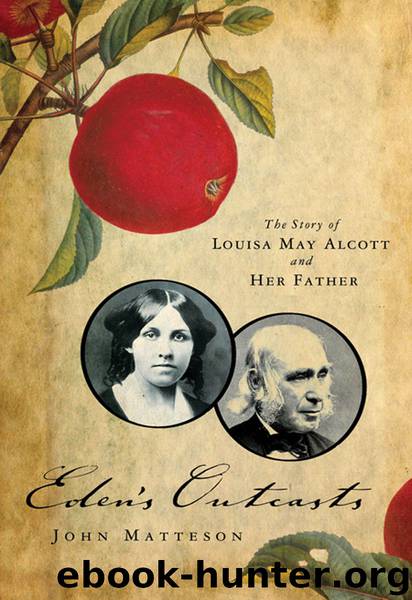0393333590 (N) by John Matteson

Author:John Matteson [Matteson, John]
Language: eng
Format: epub
Publisher: W. W. Norton & Company
Published: 2007-04-15T21:00:00+00:00
CHAPTER TEN
ORCHARD HOUSE
“My associations with the place are of the happiest and holiest kind”
—A. BRONSON ALCOTT,
Journals, April 28, 1880
BRONSON FELT HE HAD A STROKE OF GREAT FORTUNE IN acquiring Orchard House, and he was flattered when friends told him it was one of the best-placed and most picturesque houses in Concord. The location was indeed opportune. From the front door, an easy stroll up the Lexington Road brought the traveler to Concord’s handsome town square. The house was even a bit closer to Emerson’s than Hillside had been.
In England, Hawthorne received word that the Alcotts were moving into Orchard House. Surprised that Bronson had been able to afford such a purchase, he reacted to the news with pleasure, though not for the kindly reasons one might suspect. Hawthorne knew how prone Alcott was to overextend himself, and he saw nothing wrong with being in a position to reap the advantages in case the philosopher stumbled once again. With cool opportunism, he wrote to his friend Howard Ticknor, “I understand that Mr. Alcott…has bought a piece of land adjacent to mine, and two old houses on it…. If he should swamp himself by his expenditures on this place, I should be very glad to take it off his hands…. You would oblige me by having an eye to this.”1
In early October 1857, while Orchard House underwent extensive repairs, the Alcotts settled into a temporary home on Bedford Street in Concord. Believing that Lizzie’s condition had stabilized, Bronson departed on November 11 for a tour of the West. He stopped for more than a week in Buffalo, where a friend of Emerson’s introduced him to former president Fillmore. The president and the philosopher spoke for two hours, trading opinions on slavery and the recent violence in Kansas. Alcott found Fillmore “candid, conservative, and fearful of consequences.” In a letter to Abba, he paid Fillmore a left-handed compliment, pronouncing him “sincere in his timidities.”2
In Bronson’s absence Anna, Louisa, and Abby May amused themselves by acting in plays with young men from the town and the boys from Frank Sanborn’s school. Anna soon attracted the attentions of a witty twenty-four-year-old named John Pratt, while Louisa took an interest in a blond, round-cheeked, motherless boy, Alf Whitman. No relation to the poet, Whitman boarded with the Pratts and often turned up alongside John when he came to visit Anna. Although the friendship of John and Anna soon blossomed into romance, there was no such possibility for Louisa and Alf. Alf, at fifteen, was ten years Louisa’s junior. The attraction, though platonic, was nevertheless strong. They went to skating parties together, rowed on the Concord River, and acted opposite each other in a dramatization of Dickens’s The Haunted Man. For years afterward they exchanged letters signed with their character names “Dolphus” and “Sophy.” Alf thought of the Alcotts’ home as an enchanted palace.3 Louisa called Alf “my boy,” and she thought that, if she were a goddess, he would be the kind of boy she would create.
Download
This site does not store any files on its server. We only index and link to content provided by other sites. Please contact the content providers to delete copyright contents if any and email us, we'll remove relevant links or contents immediately.
| African | Asian |
| Australian & Oceanian | Canadian |
| Caribbean & Latin American | European |
| Jewish | Middle Eastern |
| Russian | United States |
4 3 2 1: A Novel by Paul Auster(11544)
The handmaid's tale by Margaret Atwood(7248)
Giovanni's Room by James Baldwin(6536)
Big Magic: Creative Living Beyond Fear by Elizabeth Gilbert(5144)
Asking the Right Questions: A Guide to Critical Thinking by M. Neil Browne & Stuart M. Keeley(5088)
Ego Is the Enemy by Ryan Holiday(4637)
On Writing A Memoir of the Craft by Stephen King(4499)
The Body: A Guide for Occupants by Bill Bryson(4352)
Ken Follett - World without end by Ken Follett(4274)
Bluets by Maggie Nelson(4073)
Adulting by Kelly Williams Brown(4063)
Guilty Pleasures by Laurell K Hamilton(3950)
Eat That Frog! by Brian Tracy(3896)
White Noise - A Novel by Don DeLillo(3661)
The Poetry of Pablo Neruda by Pablo Neruda(3629)
Alive: The Story of the Andes Survivors by Piers Paul Read(3550)
Fingerprints of the Gods by Graham Hancock(3537)
The Book of Joy by Dalai Lama(3501)
The Bookshop by Penelope Fitzgerald(3485)
